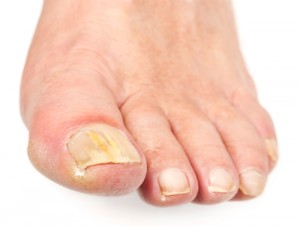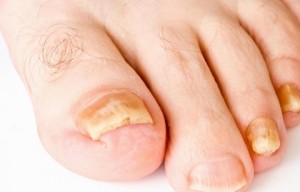Say goodbye to discoloured fungal toenails!
February 10, 2018
 It’s been a fantastic, hot summer here in New Zealand, with lots of time wearing sandals, at the beach and feeling that soft, green grass beneath of our feet. For many of our patients recently, it’s also been the time that they’ve noticed a few unusual changes in the appearance of their toenails – usually yellow and white patches – and have come in to find out what it is and what they can do about it!
For many of these patients, the verdict is the same…
It’s been a fantastic, hot summer here in New Zealand, with lots of time wearing sandals, at the beach and feeling that soft, green grass beneath of our feet. For many of our patients recently, it’s also been the time that they’ve noticed a few unusual changes in the appearance of their toenails – usually yellow and white patches – and have come in to find out what it is and what they can do about it!
For many of these patients, the verdict is the same…
It’s a fungal nail infection
A fungal nail infection, medically referred to as onychomycosis, is the infiltration of the nail by a fungus. The changes you may see in your nail occur as the fungus spreads and feeds on the keratin in your nail. In fact, approximately 50% of abnormal toenail appearance changes are caused by a fungus, and around 10% of all adults suffer from fungal nail infections. What does that mean?Fungal nail infections are easily spread
Yep, fungal infections are definitely contagious and are easily spread within households and public places. This is because fungus spreads through spores that move through the air, as well as direct contact. Fungus also thrives in warm and moist environments, and doesn’t require sunlight to grow. This makes places like showers, public pools, changing rooms, gyms and nail salons the ideal breeding ground for fungus. Once you’ve picked up an infection, the environment inside closed in shoes also provide ideal conditions for the infection to grow and persist. When you come in contact with the fungus and your immune system doesn’t clear the infection before it takes hold, the symptoms will begin. Certain conditions do make people more susceptible to infection. These include:
When you come in contact with the fungus and your immune system doesn’t clear the infection before it takes hold, the symptoms will begin. Certain conditions do make people more susceptible to infection. These include:
- Poor circulation
- Increased age
- Male gender
- A compromised immune system
- Previous trauma/injury to the feet and nails
- Family history of infection
- Diabetes
What do fungal infections look like?
Nails can appear:- Brittle
- Crumbling/flaky
- Thickened
- White/yellow/brown discolouration
- Worm-eaten appearance
Make sure it really is a fungal nail infection and not something else
It’s important to note that there are other conditions that have a similar appearance to fungal nail infections, such as psoriasis of the nail and trauma. This is why before spending time and money treating the infection, you should get a confirmed diagnosis. We can do this in our clinic in just 5 minutes, easily and painlessly from a small sample of your nail. Once we have a confirmed diagnosis, we’ll talk through the best way to treat your infection based on your symptoms and presentation. We’ll also give you all of the information you need to stop the spread of infection to your friends and family, and minimise your risk of future re-infection as much as possible! For more information or to book an appointment, give our expert team a call on 09 523 2333
